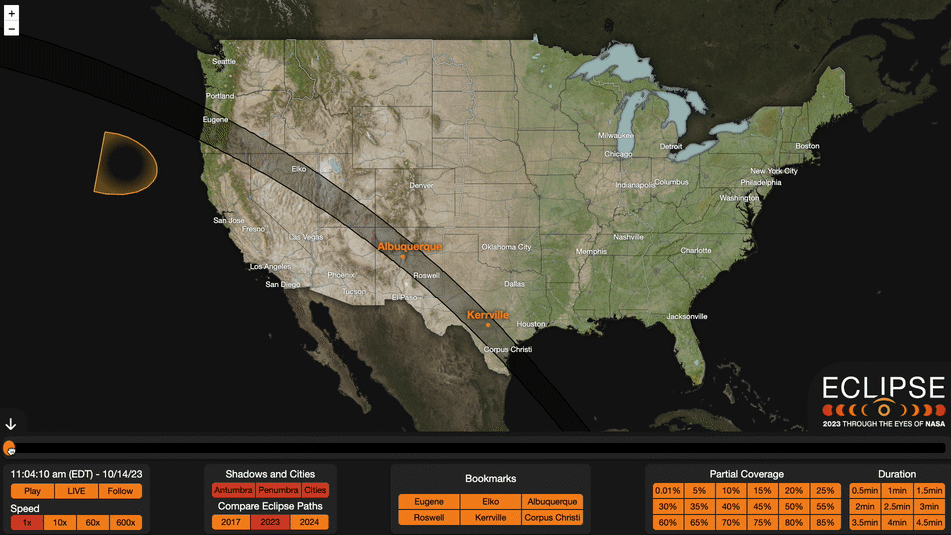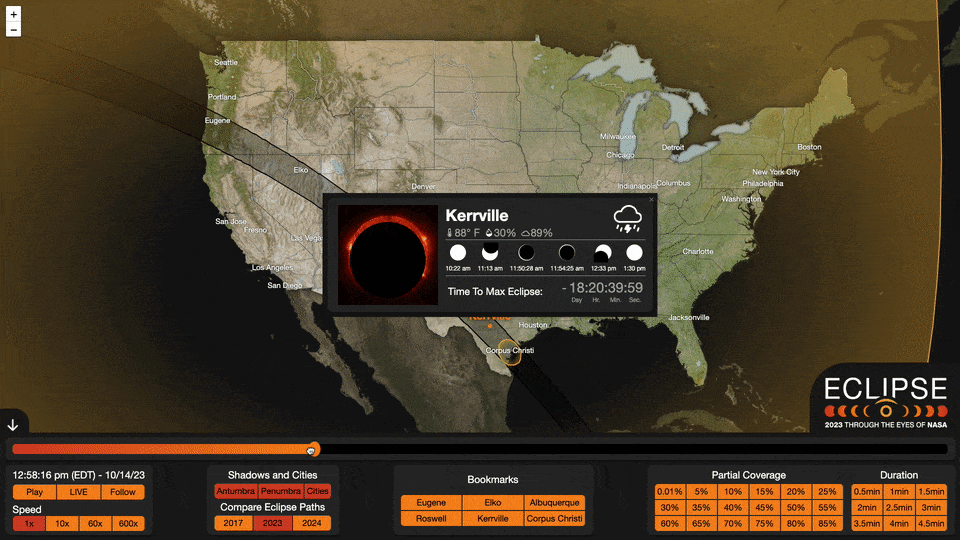NASA's Eclipse Explorer 2023 lets you track the Oct. 14 annular solar eclipse with new interactive map
The annular "ring of fire" solar eclipse will be visible across the Americas on Oct. 14, 2023.

Update for 3:45 p.m. ET: The annular solar eclipse of 2023 has completed its pass over the United States and moved into parts of Central America and South America. Read our wrap to see amazing photos and videos.
A spectacular annular solar eclipse will grace the Americas on Oct. 14 and you can track it down to the exact second with NASA's 2023 Eclipse Explorer.
The Eclipse Explorer's interactive map details when and where the eclipse will be visible, including the path and duration of annularity (the areas from which the 'ring of fire' can be seen), allowing users to dive into the eclipse viewing experience like never before.
Find out exactly when the eclipse will be visible at your location and watch how the eclipse evolves in time. You can toggle between cities and use the slider bar at the bottom to move through different stages of the eclipse.
Related: Annular solar eclipse 2023: How to watch in person and online

If you're looking for safe optics to view the eclipse, we recommend the Celestron EclipSmart 2x Power Viewers, which have 2x magnification or this travel-friendly solar telescope. You can also consult our guide to photographing the solar eclipse.
Developed by NASA's Scientific Visualization Studio (SVS) the 2023 Eclipse Explorer interface is composed of a grid of toggle buttons divided into the following categories: Shadow components, city labels (or bookmarks), eclipse paths, coverage percentages and duration intervals. Clicking any of the buttons will make that data appear (or disappear) on the map.
According to NASA the key features are:
Get the Space.com Newsletter
Breaking space news, the latest updates on rocket launches, skywatching events and more!
- Dynamic layers: Toggle lines showing what percentage of the sun will be covered at the peak of the eclipse, outlines of areas where the duration of annularity is highest, and the path and shapes of the antumbra (the darkest part of the shadow and where annularity occurs) and penumbra (the brighter parts of the shadow, where only a partial eclipse is visible).
- Time slider: Scrub through time to see the motion of the eclipse shadows across the U.S. on the day of the eclipse.
- City information: Click city labels to access detailed local data including current weather conditions and a simulated image of the eclipse for that particular location. For each city, buttons for different phases of the eclipse automatically skip to the time on the map when each of those events happen in that city.
- Countdown Widget: Count down to the moment of maximum coverage for each city.
- Auto-Play: Automatically play the eclipse forward in time at varying speeds. Clicking the "follow" toggle button will move the map to track the shadow as it moves across the landscape during the eclipse.

The famous 'ring of fire' will cross eight U.S. states from Oregon to Texas before moving across the Gulf of Mexico and over Mexico, Guatemala, Belize, Honduras, Nicaragua, Costa Rica, Panama, Colombia and Brazil.
If you're hoping to catch the eclipse in person, we have several guides to help you plan your eclipse-viewing experience ranging from top tips for planning your trip to which U.S. states the 'ring of fire' will be visible from.
REMEMBER to NEVER look at the sun directly. To safely view this solar eclipse you must use solar filters at all times. Whether your location will experience a partial solar eclipse or an annular solar eclipse, the dangers are the same. Observers will need to wear solar eclipse glasses, and cameras, telescopes and binoculars must have solar filters placed in front of their lenses at all times.
Our how to observe the sun safely guide tells you everything you need to know about safe solar observations.
Join our Space Forums to keep talking space on the latest missions, night sky and more! And if you have a news tip, correction or comment, let us know at: community@space.com.

Daisy Dobrijevic joined Space.com in February 2022 having previously worked for our sister publication All About Space magazine as a staff writer. Before joining us, Daisy completed an editorial internship with the BBC Sky at Night Magazine and worked at the National Space Centre in Leicester, U.K., where she enjoyed communicating space science to the public. In 2021, Daisy completed a PhD in plant physiology and also holds a Master's in Environmental Science, she is currently based in Nottingham, U.K. Daisy is passionate about all things space, with a penchant for solar activity and space weather. She has a strong interest in astrotourism and loves nothing more than a good northern lights chase!









